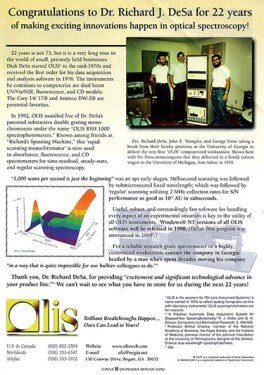Uv/vis - The Facts
Uv/vis - The Facts
Blog Article
Not known Facts About Circularly Polarized Luminescence
Table of ContentsThe 20-Second Trick For SpectrophotometersThe Of SpectrophotometersThe Main Principles Of Circularly Polarized Luminescence Fascination About Circularly Polarized LuminescenceThe 10-Second Trick For Uv/vis/nir

Spectrophotometry is most commonly applied to ultraviolet, visible, and infrared radiation, modern spectrophotometers can interrogate broad swaths of the electro-magnetic spectrum, including x-ray, ultraviolet, visible, infrared, and/or microwave wavelengths. Spectrophotometry is a tool that hinges on the quantitative analysis of molecules depending upon just how much light is taken in by colored compounds.
Not known Details About Uv/vis
A spectrophotometer is typically used for the measurement of transmittance or reflectance of options, transparent or nontransparent solids, such as sleek glass, or gases. Although numerous biochemicals are colored, as in, they take in visible light and therefore can be measured by colorimetric procedures, even colorless biochemicals can often be converted to colored compounds suitable for chromogenic color-forming responses to yield substances appropriate for colorimetric analysis.: 65 Nevertheless, they can also be created to determine the diffusivity on any of the listed light ranges that usually cover around 2002500 nm using different controls and calibrations.
An example of an experiment in which spectrophotometry is utilized is the decision of the balance constant of a service. A specific chemical reaction within a solution might take place in a forward and reverse direction, where reactants form products and items break down into reactants. At some time, this chemical response will reach a point of balance called a balance point.
4 Easy Facts About Circularly Polarized Luminescence Described
The quantity of light that travels through the solution is indicative of the concentration of certain chemicals that do not enable light to pass through. The absorption of light is because of the interaction of light with the electronic and vibrational modes of particles. Each type of molecule has an individual set of energy levels associated with the makeup of its chemical bonds and nuclei and hence will absorb light of particular wavelengths, or energies, resulting in special spectral residential or commercial properties.
Making use of spectrophotometers covers different scientific fields, such as physics, materials science, chemistry, biochemistry. spectrophotometers, chemical engineering, and molecular biology. They are widely utilized in numerous industries consisting of semiconductors, laser and optical manufacturing, printing and forensic assessment, in addition to in laboratories for the research study of chemical substances. Spectrophotometry is often utilized in measurements of enzyme activities, determinations of protein concentrations, determinations of enzymatic kinetic constants, and measurements of ligand binding reactions.: 65 Ultimately, a spectrophotometer is able to identify, depending upon the control or calibration, what compounds are present in a target and exactly how much through estimations of observed wavelengths.
This would come as a service to the hop over to these guys previously produced spectrophotometers which were unable to absorb the ultraviolet correctly.
9 Easy Facts About Circularly Polarized Luminescence Described
It would be found that this did not provide satisfactory outcomes, therefore in Model B, there was a shift from a glass to a quartz prism which permitted for much better absorbance outcomes - UV/Vis/NIR (https://linktr.ee/olisclarity1). From there, Design C was born with a change to the wavelength resolution which wound up having three units of it produced
It irradiates the sample with polychromatic light which the sample takes in depending on its homes. It is transmitted back by grating the photodiode selection which identifies the wavelength region of the spectrum. Ever since, the production and implementation of spectrophotometry gadgets has actually increased exceptionally and has turned into one of the most innovative instruments of our time.

Uv/vis/nir Things To Know Before You Buy
Historically, spectrophotometers utilize a monochromator consisting of a diffraction grating to produce the analytical spectrum. The grating can either be movable or repaired. If a single detector, such as a photomultiplier tube or photodiode is utilized, the grating can be scanned step-by-step (scanning spectrophotometer) so that the detector can determine the light strength at each wavelength (which will represent each "step").
In such systems, the grating is repaired and the strength of each wavelength of light is determined by a different detector in the range. When making transmission measurements, the spectrophotometer quantitatively compares the portion of light that passes through a reference service and a test service, then electronically compares the intensities of the two signals and computes the percentage of transmission of the sample compared to the recommendation standard.

Report this page